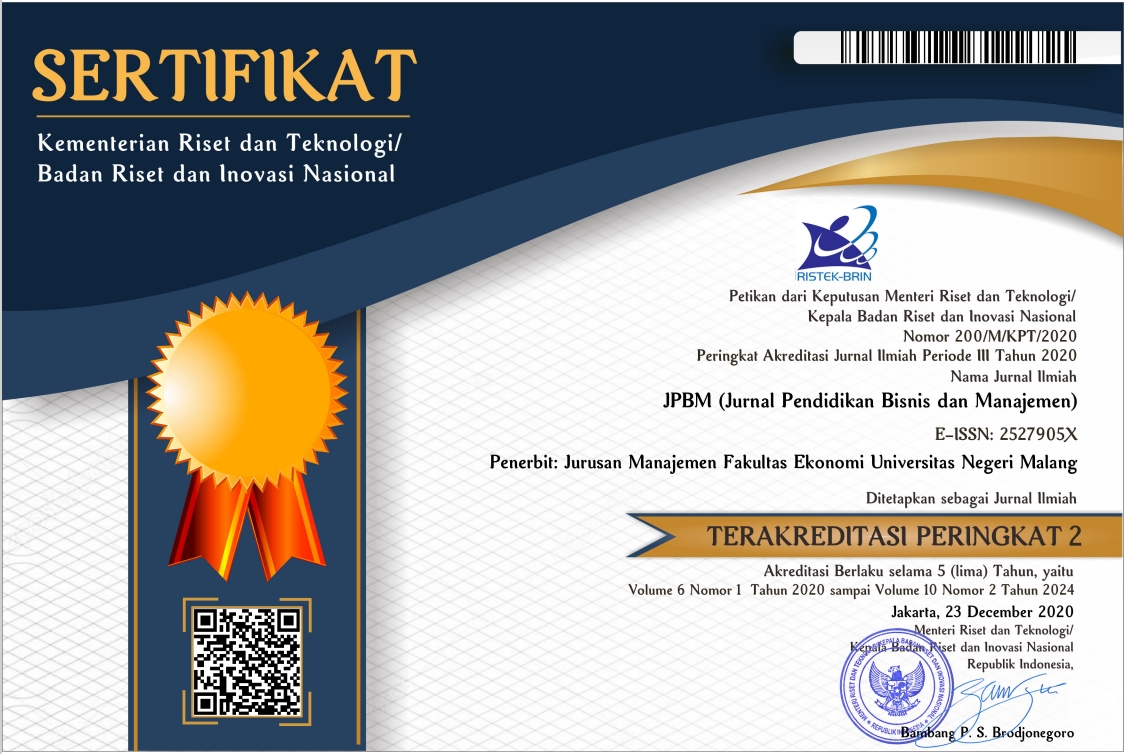Shaping the Digital Fashion Industry with Generation Z’s Buying Behavior
Abstract
Abstract: Marketing forms have evolved over time, and as the world transitions into a new generation of audiences and consumption behaviors, marketing has gone from the traditional to the more essential digital form, with the use of social media technology such as Instagram and Facebook. The main objective of this study is to empirically examine how hedonic motives, emotional response, and involvement in fashion can impact impulsive buying in the fashion industry within Generation Z. In this context, data were collected from 100 respondents in the age range of 16 to 23 years in the greater areas of Jakarta and Surabaya through an online survey. The data were then tested and finally analyzed. The most influential determinants affecting impulse buying are involvement in fashion, followed by hedonic motives, and emotional response. Even though the scarcity factor fills the gap created by prior studies’ inconsistencies, it fails to moderate the link between emotional response and impulse buying.
Keywords: Impulse buying, Hedonic behavior, Emotional response, Involvement in fashion, Scarcity
Full Text:
PDFReferences
Akram, U., Hui, P., Khan, M., Yan, C., & Akram, Z. (2018). Factors affecting online impulse buying: Evidence from Chinese social commerce environment. Sustainability (Basel, Switzerland), 10(2), 352. https://doi.org/10.3390/su10020352
Barbopoulos I., & Johansson L. O. (2017). The Consumer Motivation Scale: A detailed review of item generation, exploration, confirmation, and validation procedures. Data Brief, 5(13), 88-107. https://doi.org/10.1016/j.dib.2017.04.054
Bryman, A. (2008). Social research methods. (3rd ed.). Oxford University Press.
Chen, Y. C., Yeh, T. L., & Wang, Y. J. (2021). The drivers of desirability in scarcity marketing. Asia Pacific Journal of Marketing and Logistics, 33(4), 924-944. https://doi.org/10.1108/APJML-03-2020-0187
Destari, F., Indraningrat, K., & Putri, M. N. N. (2020). Impact of shopping emotion towards impulse buying in e-commerce platform. Jurnal Manajemen dan Pemasaran Jasa, 13(1), 47-64.
Djafarova, E., & Bowes, T. (2021). ‘Instagram Made Me Buy It’: Generation Z Impulse Purchases in Fashion Industry. Journal of Retailing and Consumer Services, 59, 102345. https://doi.org/10.1016/j.jretconser.2020.102345
Dhurup, M. (2014). Impulsive fashion apparel consumption: The role of hedonism, fashion involvement and emotional gratification in fashion apparel impulsive buying behaviour in a developing country. Mediterranean Journal of Social Sciences, 5(8), 168-177. http://dx.doi.org/10.5901/mjss.2014.v5n8p168
Ghozali, I. (2008). Structural equation modeling metode alternatif dengan partial least square. Semarang: Badan Penerbit Universitas Diponegoro.
Goryunova, E., & Jenkins, D. (2023). Digital natives. In: Marques, J. F., Schmieder-Ramirez, J., Malakyan, P. G. (eds) Handbook of Global Leadership and Followership. Springer, Cham. https://doi.org/10.1007/978-3-031-21544-5_22
Hamilton, R., Thompson, D., Bone, S., Chaplin, L. N., Griskevicius, V., Goldsmith, K., Hill, R., John, D. R., Mittal, C., O’Guinn, T., Piff, P., Roux, C., Shah, A., & Zhu, M. (2019). The effects of scarcity on consumer decision journeys. Journal of the Academy of Marketing Science, 47, 532-550. https://doi.org/10.1007/s11747-018-0604-7
Henseler, J., Ringle, C. M., & Sinkovics, R. R. (2009). The use of partial least squares path modeling in international marketing. Advances in International Marketing, 20(1), 277-319.
Hodkinson, C. (2016). ‘Fear of Missing Out’ (FOMO) marketing appeals: A conceptual model. Journal of Marketing Communications, 25(1), 65-88. https://doi.org/10.1080/13527266.2016.1234504
Kochhar, N. (2020). Social media marketing in the fashion industry: A systematic literature review and research agenda [Master’s thesis, University of Manchester]. https://pure.manchester.ac.uk/ws/portalfiles/portal/194687249/FULL_TEXT.PDF
Li, M., Taiyang, Z., Ershuai, H., & Li, J. (2020). How does a public health emergency motivate people’s impulsive consumption? An empirical study during the COVID-19 Outbreak in China. International Journal of Environmental Research and Public Health, 17(14), 5019. https://doi.org/10.3390%2Fijerph17145019
O’Cass, A. (2004). Fashion clothing consumption: Antecedents and consequences of fashion clothing involvement. European Journal of Marketing, 38(7), 869-882. https://doi.org/10.1108/03090560410539294
Pangaribuan, C. H., Setiawan, J., Hidayat, D., Putra, O. P. B., Ardiansyah, M., & Putra, C. A. M. (2021). Mobile game stickiness, perceived playfulness, and interests of digital goods purchase: An empirical study on mobile gamers in Indonesia. 3rd International Conference on Cybernetics and Intelligent System (ICORIS), pp. 1-6. https://ieeexplore.ieee.org/abstract/document/9649560
Park, E. J., & Kim, E. Y. (2008). Effects of consumer tendencies and positive emotion on impulse buying behavior for apparel. Journal of the Korean Society of Clothing and Textiles, 32(6), 980-990. https://doi.org/10.5850/jksct.2008.32.6.980
Plume, C. J., Dwivedi, Y. K., & Slade, E. L. (2017). Chapter 5 - Self-construals. In Social Media in the Marketing Context (pp. 93-127). Elsevier Ltd. https://doi.org/10.1016/B978-0-08-101754-8.00005-5
Prilyantinasari, P., & Mulyana, A. (2020). The effect of Instagram exposure of hedonic lifestyle on dissonance rates for digital native. International Journal of Environment, Agriculture and Biotechnology, 5(2), 396-402. https://dx.doi.org/10.22161/ijels.52.10
Sekaran, U., & Bougie, R. (2013). Research methods for business (Seventh Ed.). Wiley.
Skeldon, P. (2020). Gen Z and Millennial Shoppers Have Shifted Online and the Move is Permanent for Many. Internet Retailing. Retrieved from https://internetretailing.net/gen-z-and-millennial-shoppers-have-shifted-online-and-the-move-is-permanent-for-many-22461/
Sumarmi, S., & Prasyanti, P. A. (2021). Impulse buying in fashion retail: Evidence at the department store in Daerah Istimewa Yogyakarta. Jurnal Ilmiah Manajemen dan Bisnis, 7(1), 36-49.
Utami, Y., Kendaga, J. A. F., Diantoro, A. K., & Kusmantini, T. (2021). The influence of hedonistic motives, fashion interest, and positive emotions on the impulsive buying of fashion products with sales promotion as moderating variables. International Journal of Applied Business and International Management, 6(3), 56-69. https://doi.org/10.32535/ijabim.v6i3.1329
Vyse, S. (2018). The environment and consumer behavior. Environmental Psychology and Human Well-Being, 8, 193-220. https://doi.org/10.1016/B978-0-12-811481-0.00008-1
Weinberg, P., & Gottwald, W. (1982). Impulsive consumer buying as a result of emotions. Journal of Business Research, 10(1), 43–57. https://doi.org/10.1016/0148-2963(82)90016-9
Wolfinbarger, M. & Gilly, M. C. (2001). Shopping online for freedom, control, and fun. California Management Review, 43(2), 34-55. https://doi.org/10.2307/41166074
Yu, Y. (2022). Effects of negative emotions and cognitive characteristics on impulse buying during COVID-19. Frontiers in Psychology, 13, 848256–848256. https://doi.org/10.3389/fpsyg.2022.848256
Zhang, J., Jiang, N., Turner, J. J., & Pahlevan-Sharif, S. (2021) The impact of scarcity on consumers’ impulse buying based on the S-O-R Theory. Frontiers in Psychology, 13, 792419. https://doi.org/10.3389/fpsyg.2022.792419
DOI: http://dx.doi.org/10.17977/um003v9i32023p188
Refbacks
- There are currently no refbacks.
JPBM (Jurnal Pendidikan dan Bisnis Manajemen) is licensed under a Creative Commons Attribution-NonCommercial-ShareAlike 4.0 International License.
JPBM (Jurnal Pendidikan dan Bisnis Manajemen) is abstracted and indexed in :
















